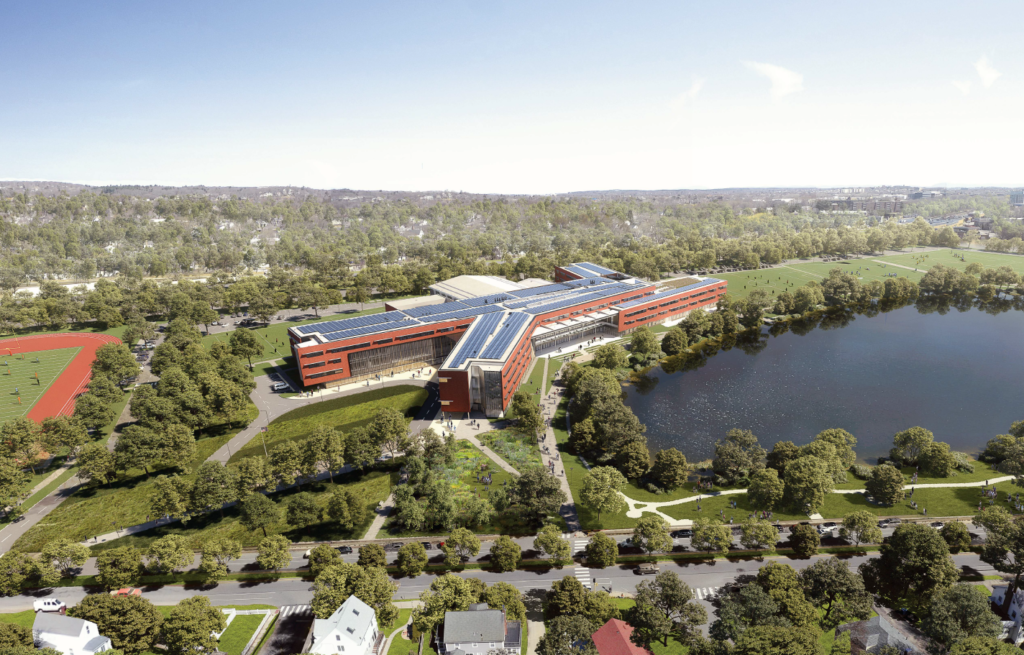By Jacob Knowles
The latest climate science indicates that we must reverse the historic trend of emissions escalation and begin actively extracting CO2 from the atmosphere. Energy consumption by buildings represents 28 percent of annual global greenhouse gas (GHG) emissions, which means that zero net energy (ZNE) buildings are a core component of achieving a livable climate.
On the bright side, there has been exponential growth in ZNE buildings, with a 700 percent increase between 2012 and 2019 in completed and emerging ZNE buildings in the US and Canada, as documented by the New Buildings Institute. This growth is happening not only in response to climate change, but because ZNE buildings have become financially attractive.
Locally, Belmont High School generates more than 40 percent of the total GHG emissions for all municipal buildings in Belmont. The new Belmont Middle and High School (BMHS) will be nearly twice as large, the single greatest financial investment in the history of Belmont, and is also anticipated to serve our town until at least the year 2100.

Although the new Belmont Middle and High School is slated to be nearly twice the size of the existing high school, it will be carbon neutral because of its zero net energy design. (Image courtesy of Perkins and Will)
It is critical, therefore, that the new BMHS align with Belmont’s Climate Action Plan. To that end, through great effort over the past two years by Belmont residents, by the Belmont High School Building Committee, and by the design consultant team, the school will be the flagship in reducing Belmont’s carbon emissions in the municipal sector.
What does that mean? The BMHS has been designed to achieve ZNE by relying entirely on renewable energy on a net annual basis, making its operation carbon neutral. This starts with an efficient envelope, lighting, and mechanical systems. Rather than fossil-fuel boilers, a geothermal heat pump system will be used to provide heating and cooling. A solar array covering the roof will produce one third of the energy. The remaining energy will be purchased from third-party suppliers, resulting in an increase in state incentives that more than offsets the cost of the third-party renewable energy, making it a cash-flow positive transaction for Belmont.
Because BMHS construction is being financed by a bond, Belmont taxpayers do not pay anything upfront. They do, on the other hand, pay for the construction over time as Belmont pays down the bond. Because the reduction in building operating costs is greater than the bond payments associated with the ZNE-enhancements, the net cash flow is positive from year one. Therefore, the payback is immediate.
In total, achieving ZNE for the BMHS is estimated to result in more than $5 million in net present savings to Belmont taxpayers. This includes the cost to build, maintain, and replace system components over the initial 30-year period. It also accounts for energy savings and financial incentives. Additional operating savings and financial incentives will accrue beyond the 30-year timeframe.
The environmental and educational benefits, and in particular the compelling financial case, spurred the Belmont Select Board and Belmont School Committee to unanimously adopt resolutions to achieve ZNE for the BMHS. The ZNE BMHS will not only save taxpayer dollars and help lead the way on Belmont’s Climate Action Plan, it will also act as a catalyst in the region, offering an example for other communities to follow.
Jacob Knowles is the Energy Committee liaison to the Belmont Middle and High School Building Committee and director of sustainable design at BR+A Consulting Engineers.


Sorry, the comment form is closed at this time.